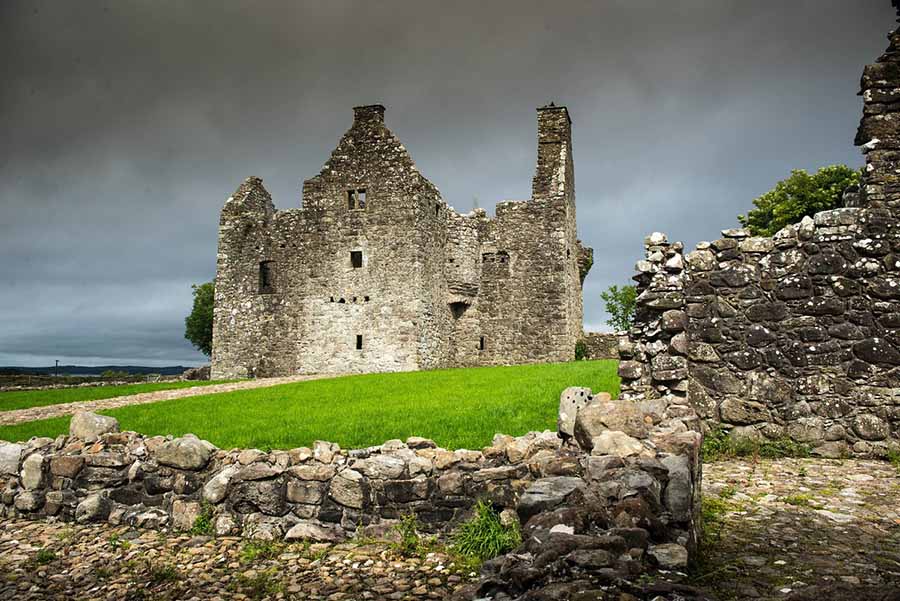
Tully Castle, located on Tully Point near Blaney, County Fermanagh, is a striking 17th-century fortified house and bawn set on the scenic shores of Lower Lough Erne. Built in 1612–1615 for Scottish planter John Hume, the castle is a State Care Historic Monument known for its turbulent history and picturesque ruins.
Tully Castle, a Scottish-style fortified house with a rectangular bawn and four corner towers, was built during the Ulster Plantation for John Hume. Its violent history culminated in the Irish Rebellion of 1641, when Rory Maguire attacked on Christmas Eve, leading to the massacre of 15 men and 60 women and children after Lady Mary Hume surrendered, believing safe conduct was assured. The castle was burned and never inhabited again, leaving evocative ruins that stand nearly full height in parts, with the bawn’s northeast wall and cellar particularly notable.
Visitors can explore the castle’s footprint, including the barrel-vaulted ground floor (used as a kitchen and storeroom) and a Scottish-style quarter-round turret projection. Information boards provide vivid accounts of the 1641 events from the occupants’ perspective, bringing the site’s grim history to life.
Visitor Centre and Exhibition:
- A small visitor centre, housed in a restored farmhouse near the castle entrance, features an exhibition with panels detailing local stories and the castle’s history. The centre offers insights into the Plantation era and the 1641 rebellion, though it has limited exhibits, and visitors can peek through windows if it’s closed.
- The centre is staffed by a ranger during open hours, and admission is free, making it accessible for all. However, some visitors note that the centre is occasionally closed (possibly due to staffing or seasonal restrictions), so checking ahead is advisable.
Scenic Grounds and Walks:
- The castle grounds, open year-round, offer a tranquil setting with commanding views of Lower Lough Erne and nearby islands (Heron, Gay, and Inishmakill), which are significant for wild bird populations. A well-maintained, short walking route (part of the Tully Castle Walk) skirts the loughshore, passing through mixed woodland and offering stunning vistas, ideal for a leisurely stroll or picnic.
- A paved path leads from the castle to the lake, and a scenic walkway around the headland provides additional exploration opportunities. The site is dog-friendly, and the large parking area and grassy spaces are suitable for families, though no picnics are allowed within the formal grounds.
- The castle’s jetty, accessible by boat from Enniskillen, makes it a unique stop for water-based visitors, though some note the lack of facilities like water, electricity, or bins at the jetty.
Accessibility and Amenities:
- The site is free to enter, with a large car park and disabled parking closer to the visitor centre. A 50-yard cobble-like path to the castle will be bumpy for wheelchairs, but the tarmac road and loughshore path are more accessible. Large coaches should use the second car park for wider access. Toilets are available at the visitor centre entrance.
- No unaccompanied children under 16 are allowed, ensuring a safe environment. The site is compact, with visits typically taking 30–60 minutes, making it an ideal stop for those exploring Fermanagh Lakelands or nearby attractions like Castle Archdale Country Park or Enniskillen Castle.
Atmosphere and Visitor Feedback:
- Visitors describe Tully Castle as a “historic gem” with a “picturesque” and “tranquil” setting, ideal for a short visit or picnic. The ruins and lough views are highlights, though some express disappointment over the absence of formal gardens or hedging, which may have been removed or overstated in promotional materials.
- The site’s haunting history, with tales of ghostly apparitions linked to the 1641 massacre, adds an eerie allure for some, though this is more folklore than verified. Reviewers note a “dark, brooding atmosphere” that fuels ghost stories.
- While generally well-received, some visitors report disturbances from local groups at the jetty, suggesting timing visits for quieter periods (e.g., mornings) may enhance the experience.
What’s New:
- Continued Seasonal Operations: The visitor centre operates on a seasonal schedule, typically open Wednesday to Sunday from 10:00 AM to 5:00 PM (last admission 4:30 PM) from July to mid-September. The castle grounds remain open year-round. While no changes to this schedule are confirmed, visitors should verify opening times via www.communities-ni.gov.uk or www.fermanaghlakelands.com, as closures (e.g., due to weather or staffing) have occurred in the past.
- Potential Enhancements to Visitor Experience: The removal of box hedging and flowers, noted by visitors in 2024, suggests a shift to a simpler landscape of mown grass, which may disappoint those expecting the “beautiful 16th-century garden” mentioned in some descriptions. No plans to restore these gardens are confirmed, but the site’s maintenance as a State Care Historic Monument suggests ongoing efforts to preserve the ruins and grounds. Visitors should expect a focus on the castle’s historical narrative rather than formal gardens.
- The Cuilcagh Lakelands Geopark, which includes Tully Castle, emphasizes sustainable tourism., there will be new interpretive materials or guided tours highlighting the site’s role in the Geopark’s ecological and historical narrative, funded by initiatives like the Stormont government’s Rural Development Programme.
Visitors to Tully Castle can expect a free, atmospheric visit to a well-preserved 17th-century ruin with a haunting history, set against the stunning backdrop of Lower Lough Erne. The castle’s stone walls, bawn, and cellar, paired with information boards and a small visitor centre, offer a concise yet evocative dive into the Plantation era and the 1641 rebellion. The surrounding grounds and loughshore walk provide a serene setting for walks or picnics, though the absence of formal gardens may temper expectations. The jetty makes it a unique stop for boaters, but limited facilities (e.g., no bins or water) require planning. The visitor centre’s seasonal hours (July to mid-September) and potential closures mean checking ahead is essential., expect a focus on historical and ecological interpretation, with new signage or Geopark-related events, but no major changes are confirmed. For the latest details, visit www.communities-ni.gov.uk or www.fermanaghlakelands.com, or contact the Department for Communities at +4428 9082 3207.



